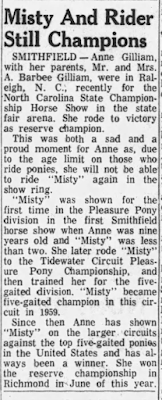Chincoteague ponies are classic children’s mounts and have seen success in the hunter/jumper, dressage, and western ring… but have you ever heard of Chincoteague as a five-gaited champion?
Modern Chincoteague ponies are not gaited, meaning they do not have gaits other than the walk, trot, and canter. Gaited horse breeds like the Tennessee walking horse or the Paso Fino naturally have gaits beyond the standard walk, trot, and canter—for example, the Paso Fino has special, four-beat gaits unique to the breed.
Gaits other than the walk, trot, and canter haven’t been noted in the Chincoteague pony breed since the late 1800s, when a Canadian stallion let loose on the island imparted the pace to his offspring.
However, in the late 1950s, a girl named Ann Gilliam set out to change that.
As a young girl, Gilliam wanted a show pony, so her father bought her a Chincoteague pony in an attempt to dissuade her from showing—his reasoning was that if he bought her a "plain, ordinary pony," she would get bored with showing and would sell it.
In July of 1952, a horse dealer named Cecil Gale brought a truckload of six Chincoteague pony foals fresh from the auction to her father's store. She selected her favorite out of the bunch, a tiny black and white pinto she naturally named Misty after the storybook pony.
.png) |
| Gilliam and Misty in 1957. |
Gilliam couldn't wait to train her first pony, and she broke Misty very young, showing the pony in riding classes as a yearling.
Misty was a funny-looking pony. As one reporter wrote, "Misty is always tops in performance but usually looses [sic] points on conformation. Her neck is too short and her back too long. It is a wonder she isn't swayback."
After her first show season as a pleasure pony, Misty took a couple years off to raise two foals while Gilliam got more riding experience riding with Gale, a breeder of Hackney ponies.
Following their hiatus, the pair showed more in pleasure classes, earning many ribbons, including the 1956 Virginia State Pleasure Pony Championship.
After riding and showing gaited ponies like Gale’s, had a new goal: show Misty in gaited classes.
In the five-gaited pony classes Gilliam wanted to compete in, ponies are required to walk, trot, canter, rack, and slow gait. These are commonly associated with the American saddlebred, who have been bred for decades to perform those gaits.
To Chincoteague ponies, the gaits do not come naturally—but Gilliam was determined to train Misty to rack and slow gait.
"To my knowledge, Misty is the only Chincoteague pony to ever show in five-gaited," she told a reporter in 1961.
.png) |
| Misty and Gilliam in 1960. |
She entered Misty in the 1957 Virginia Beach show in the five-gait class and started training the pony to gait. Two days before the show, Misty racked for the first time, and she was able to rack —albeit poorly—in the show.
Misty continued to show in 1958 in both pleasure and five-gaited classes. That year, she won the five-gaited pony and open championships at Suffolk, and in 1959, she earned the Five-Gaited Pony Championship.
She eventually convinced her father to buy her a real, five-gaited Saddlebred to train and show, but she continued to show Misty in the five-gaited classes.
By 1959, the pair had earned 88 ribbons in total!
Gilliam said that she wanted to turn Misty into a roadster (driving) pony so she could continue showing her past the age of eighteen. I’ve found some records of her showing a pony named “Misty’s Folly” in the roadster classes in the early 60s—perhaps this was a new, ironic name for Misty referring to her unlikely gaits.
 |
| Newport News Daily Press, October 9th 1961 |
Some horses who are not a gaited breed can perform gaits… it’s just unlikely and probably a little awkward. The fact that Misty was trained to gait and was successful in the show ring makes her stand out from the crowd.
Comments
Post a Comment